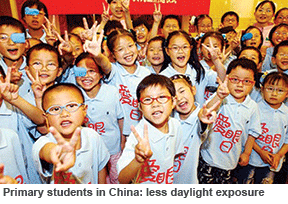 Sparkly, spotted or Hello Kitty: every colour, theme, shape and size of frame is available at Eyeglass City in Beijing, a four-storey mall crammed only with spectacle shops. Within half an hour, a pair of prescription eyeglasses is ready. That is impressive, but then the number of Chinese wearing glasses is rising. Most new adoptees are children.
Sparkly, spotted or Hello Kitty: every colour, theme, shape and size of frame is available at Eyeglass City in Beijing, a four-storey mall crammed only with spectacle shops. Within half an hour, a pair of prescription eyeglasses is ready. That is impressive, but then the number of Chinese wearing glasses is rising. Most new adoptees are children.
In 1970, fewer than a third of 16-18-year-olds were deemed to be short-sighted (meaning that distant objects are blurred). Now nearly four-fifths are, and even more in some urban areas. A fifth of these have ‘high myopia’, that is, anything beyond 16 cm (just over six inches) is unclear. The fastest increase is among primary school children, over 40 percent of whom are short-sighted, double the rate in 2000. That compares with less than 10 percent of this age group in America or Germany.
The incidence of myopia is high across East Asia, afflicting 80-90 percent of urban 18-year-olds in Singapore, South Korea and Taiwan. The problem is social rather than genetic. A 2012 study of 15,000 children in the Beijing area found poor sight is significantly associated with more time spent studying, reading or using electronic devices — along with less time spent outdoors.
The biggest cause of short-sightedness is a lack of time spent outdoors. Exposure to daylight helps the retina release a chemical that slows down an increase in the eye’s axial length, which is what most often causes myopia. A combination of not being outdoors and doing lots of intensive work like focusing up close (writing characters or reading) worsens the problem. But if a child has enough time in the open, she can study all she likes and her eyesight won’t suffer, says Ian Morgan of Australian National University.
Yet China and many other East Asian countries do not prize time outdoors. At the age of six, children in China and Australia have similar rates of myopia. Once they start school, Chinese children spend about an hour a day outside, compared with three or four hours for Australian children. School students in China are often made to take a nap after lunch rather than play outside; then they go home to do far more homework than anywhere outside East Asia. The older children in China are, the more they stay indoors — and not because of the country’s notorious pollution.
Since poor sight is associated with higher incomes and more schooling, it’s less prevalent in rural areas of China. In the countryside, a third of primary-school students are myopic, compared with nearly half of urban children, according to the health ministry. But rural eyesight problems are somewhat different. Stanford University’s Rural Education Action Programme found one in six rural children with poor sight don’t wear glasses — thanks to a combination of cost, poor eye care in schools, and a mistaken belief that wearing glasses weakens eyes further.
When Stanford gifted glasses to thousands of students free of charge, it found being able to see clearly had a higher impact on educational attainment than improving nutrition or the quality of teaching, says the programme’s co-director, Scott Rozelle. Another study reported that giving students free glasses improved test scores by the equivalent of nearly a year’s extra education. Daylight and free glasses are both cheap remedies for a growing national problem. All that’s required now is a bit of vision.
(Excerpted and adatped from The Economist)